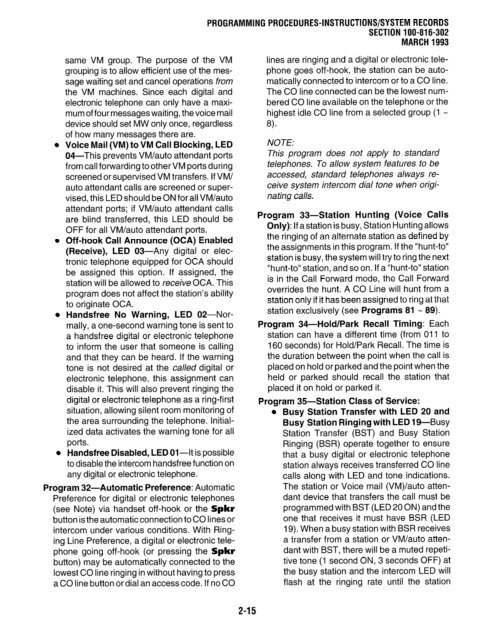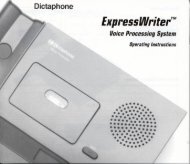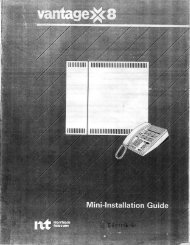Strata DK 16 Manual
Strata DK 16 Manual
Strata DK 16 Manual
Create successful ePaper yourself
Turn your PDF publications into a flip-book with our unique Google optimized e-Paper software.
0<br />
same VM group. The purpose of the VM<br />
grouping is to allow efficient use of the mes-<br />
sage waiting set and cancel operations from<br />
the VM machines. Since each digital and<br />
electronic telephone can only have a maxi-<br />
mum of four messages waiting, the voice mail<br />
device should set MW only once, regardless<br />
of how many messages there are.<br />
Voice Mail (VM) to VM Call Blocking, LED<br />
04-This prevents VM/auto attendant ports<br />
from call forwarding to other VM ports during<br />
screened or supervised VM transfers. If VM/<br />
auto attendant calls are screened or super-<br />
vised, this LED should be ON for all VM/auto<br />
attendant ports; if VM/auto attendant calls<br />
are blind transferred, this LED should be<br />
OFF for all VM/auto attendant ports.<br />
Off-hook Call Announce (OCA) Enabled<br />
(Receive), LED 03-Any digital or elec-<br />
tronic telephone equipped for OCA should<br />
be assigned this option. If assigned, the<br />
station will be allowed to receive OCA. This<br />
program does not affect the station’s ability<br />
to originate OCA.<br />
Handsfree No Warning, LED 02-Nor-<br />
mally, a one-second warning tone is sent to<br />
a handsfree digital or electronic telephone<br />
to inform the user that someone is calling<br />
and that they can be heard. If the warning<br />
tone is not desired at the called digital or<br />
electronic telephone, this assignment can<br />
disable it. This will also prevent ringing the<br />
digital or electronic telephone as a ring-first<br />
situation, allowing silent room monitoring of<br />
the area surrounding the telephone. Initial-<br />
ized data activates the warning tone for all<br />
ports.<br />
Handsfree Disabled, LED 01-It is possible<br />
to disable the intercom handsfree function on<br />
any digital or electronic telephone.<br />
Program 32-Automatic Preference: Automatic<br />
Preference for digital or electronic telephones<br />
(see Note) via handset off-hook or the Spkr<br />
button is the automatic connection to CO lines or<br />
intercom under various conditions. With Ring-<br />
ing Line Preference, a digital or electronic tele-<br />
phone going off-hook (or pressing the Spkr<br />
button) may be automatically connected to the<br />
lowest CO line ringing in without having to press<br />
a CO line button or dial an access code. If no CO<br />
PROGRAMMING PROCEDURES-INSTRUCTIONS/SYSTEM RECORDS<br />
SECTION 100-8<strong>16</strong>-302<br />
MARCH 1993<br />
2-15<br />
lines are ringing and a digital or electronic tele-<br />
phone goes off-hook, the station can be auto-<br />
matically connected to intercom or to a CO line.<br />
The CO line connected can be the lowest num-<br />
bered CO line available on the telephone or the<br />
highest idle CO line from a selected group (1 -<br />
8).<br />
NOTE:<br />
This program does not apply to standard<br />
telephones. To allow system features to be<br />
accessed, standard telephones always re-<br />
ceive system intercom dial tone when origi-<br />
na ting calls.<br />
Program 33-Station Hunting (Voice Calls<br />
Only): If astation is busy, Station Hunting allows<br />
the ringing of an alternate station as defined by<br />
the assignments in this program. If the “hunt-to”<br />
station is busy, the system will try to ring the next<br />
“hunt-to” station, and so on. If a “hunt-to” station<br />
is in the Call Forward mode, the Call Forward<br />
overrides the hunt. A CO Line will hunt from a<br />
station only if it has been assigned to ring at that<br />
station exclusively (see Programs 81 - 89).<br />
Program 34-Hold/Park Recall Timing: Each<br />
station can have a different time (from 011 to<br />
<strong>16</strong>0 seconds) for Hold/Park Recall. The time is<br />
the duration between the point when the call is<br />
placed on hold or parked and the point when the<br />
held or parked should recall the station that<br />
placed it on hold or parked it.<br />
Program 35-Station Class of Service:<br />
l Busy Station Transfer with LED 20 and<br />
Busy Station Ringing with LED 19-Busy<br />
Station Transfer (BST) and Busy Station<br />
Ringing (BSR) operate together to ensure<br />
that a busy digital or electronic telephone<br />
station always receives transferred CO line<br />
calls along with LED and tone indications.<br />
The station or Voice mail (VM)/auto atten-<br />
dant device that transfers the call must be<br />
programmed with BST (LED 20 ON) and the<br />
one that receives it must have BSR (LED<br />
19). When a busy station with BSR receives<br />
a transfer from a station or VM/auto atten-<br />
dant with BST, there will be a muted repeti-<br />
tive tone (1 second ON, 3 seconds OFF) at<br />
the busy station and the intercom LED will<br />
flash at the ringing rate until the station





